
Barro Colorado Island (BCI) is located in the man-made Gatun Lake in the middle of the Panama Canal. The island was formed when the waters of the Chagres River were dammed to form the lake in 1913. When the waters rose, they covered a significant part of the existing tropical forest, but certain hilltops remained as islands in the middle of the lake. It has an area of 15.6 km2 (6.0 sq mi).

Chaenomeles is a genus of three species of deciduous spiny shrubs, usually 1–3 m tall, in the family Rosaceae. They are native to Southeast Asia. These plants are related to the quince and the Chinese quince, differing in the serrated leaves that lack fuzz, and in the flowers, borne in clusters, having deciduous sepals and styles that are connate at the base.

Silene acaulis, known as moss campion or cushion pink, is a small mountain-dwelling wildflower that is common all over the high arctic and tundra in the higher mountains of Eurasia and North America,. It is an evergreen perennial flowering plant in the carnation family Caryophyllaceae.

Astilbe is a genus of 18 species of rhizomatous flowering plants within the family Saxifragaceae, native to mountain ravines and woodlands in Asia and North America. Some species are known by the common names false goat's beard and false spirea.

Bistorta affinis, the Himalayan bistort, fleece flower, or knotweed, is a species of flowering plant in the family Polygonaceae, native to the Himalayas.

Chaenomeles speciosa, the flowering quince, Chinese quince, or Japanese quince, is a thorny deciduous or semi-evergreen shrub native to eastern Asia. It is taller than another commonly cultivated species, C. japonica, usually growing to about 2 m. The flowers are usually red, but may be white or pink. The fruit is a fragrant but hard pome that resembles a quince.
Gustavia longepetiolata is a species of woody plant in the family Lecythidaceae. It is found only in Brazil. It is threatened by habitat loss.
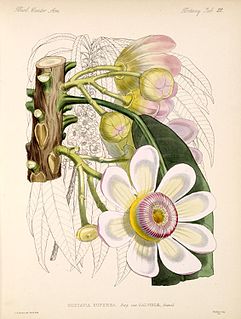
Gustavia is a genus of flowering plants in the family Lecythidaceae described by Linnaeus in 1775. It is native to tropical Central America and South America. Many of the species are threatened; some are critically endangered Gustavia superba, though, is actually abundant in re-growing secondary forests. It grows in northern South America, from Panama south through the Andes as far as Ecuador, and along the Caribbean coast and in the Amazon basin.
Membrillo is a Spanish language common name for several species of plants:

Erythronium revolutum is a species of flowering plant in the family Liliaceae which is known by several common names, including mahogany fawn lily, coast fawn lily, and pink fawn lily. It is native to the west coast of North America.
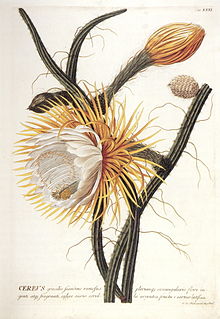
Selenicereus grandiflorus is a cactus species originating from the Antilles, Mexico and Central America. The species is commonly referred to as queen of the night, night-blooming cereus, large-flowered cactus, sweet-scented cactus or vanilla cactus. The true species is extremely rare in cultivation. Most of the plants under this name belong to other species or hybrids. It is often confused with the genus Epiphyllum.

Gustavia superba is an understory tree that grows in Central and north-western South America. Common names include membrillo, sachamango and heaven lotus. The trunk is around 5-10m high with the leaves radiating from the top.

Salvia is the largest genus of plants in the sage family Lamiaceae, with nearly 1000 species of shrubs, herbaceous perennials, and annuals. Within the Lamiaceae, Salvia is part of the tribe Mentheae within the subfamily Nepetoideae. One of several genera commonly referred to as sage, it includes two widely used herbs, Salvia officinalis and Salvia rosmarinus.

Saint Barthélemy, officially the French: Collectivité territoriale de Saint-Barthélemy, is an overseas collectivity of France in the Caribbean. Often abbreviated to St-Barth in French, and St. Barths or St. Barts in English. The island lies about 35 kilometres (22 mi) south-east of the Caribbean island Saint Martin, and is north-east of the Dutch islands of Saba, Sint Eustatius, and the independent country of Saint Kitts and Nevis.

Entheus priassus is a species of skipper butterfly from Central and South America. It is a specialist herbivore on the leaves of Gustavia superba (Lecythidaceae).
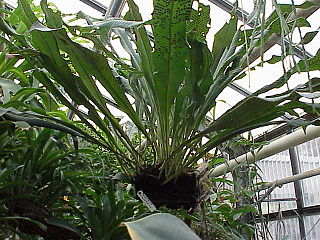
Niphidium crassifolium, commonly known as the graceful fern, is a species of fern in the family Polypodiaceae found in Central and South America. It is predominantly epiphytic, growing on other plants—for example, in the canopies of trees—but occasionally grows on rocks or on the ground, particularly at higher altitude. It has a rhizome from which many fine rootlets covered in dark reddish-brown scales grow. Together they form a root basket that, when growing on trees, helps to trap leaf litter and dust, forming a nutrient-rich soil that holds water. Its leaves are simple in shape, 13–85 centimetres (5–33 in) long and 3–5 centimetres (1.2–2.0 in) wide and when dry, and covered by a wax-like film. The sori are round and large, occurring in single rows between veins at the far end of the leaf.

Cyanea superba is a rare species of flowering plant in the bellflower family known by the common names Mt. Kaala cyanea and superb cyanea. It is endemic to the island of Oahu, but it is now extinct in the wild. It exists in cultivation and some individuals have been planted in appropriate habitat. It is a federally listed endangered species of the United States. Like other Cyanea it is known as haha in Hawaiian.
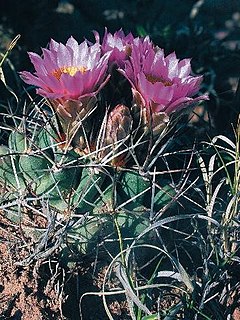
Sclerocactus glaucus is a rare species of cactus known by the common name Colorado hookless cactus. It is endemic to Colorado in the United States, where it is known only from the area between Grand Junction and Montrose. It is a federally listed threatened species.
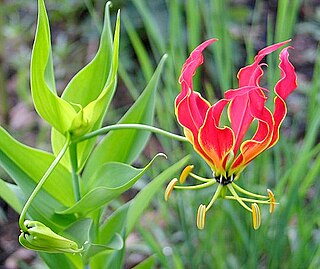
Gloriosa superba is a species of flowering plant in the family Colchicaceae. Common names include flame lily, climbing lily, creeping lily, glory lily, gloriosa lily, tiger claw, and fire lily.
Genoplesium superbum, commonly known as the pink midge orchid or superb midge orchid, is a small terrestrial orchid which is endemic to New South Wales. It has a single thin leaf and up to fifteen dark pinkish-purple flowers which lean downwards. It is listed as "endangered" in New South Wales because of its limited distribution and disturbance of its habitat.
















